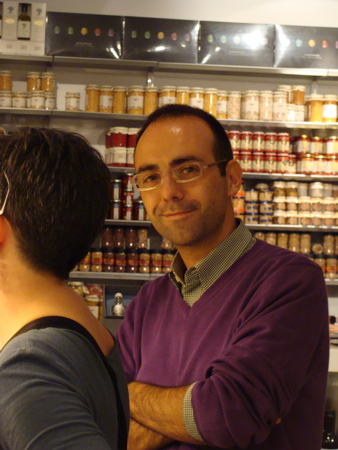
Teresa Parker blogs about restaurants, recipes, and the reasons why she's in love with Spain's food and culture.

If you think the harried shop shopkeepers of Barcelona are ignoring you just because you’re a tourist, you would be wrong (oh, all right, you might be wrong).
Maybe it’s just that you don’t know the seemingly disorganized, fabulously efficient, time-honored rules for waiting your turn in Spain. Queueing-related angst nearly ruined my recent summer pilgrimage to the rope-soled shoes mecca, La Manual Alpargatería, in Barcelona. The place normally dredges up issues for me, in a good way. I mean, do I really need the sexy, sparkly, red peep-toe espadrilles with the dark soles? And if not, what am I doing wrong? But just as I was getting into the groove of my crucial inner dialogue, an exasperated British voice knocked me off course: “Let’s just leave – they’re never going to wait on us.”
The owners at La Manual insist on doing certain things the old fashioned way. They know how to fit the uptown ladies in cheery, mid-heel monotones, the first communion candidates in custom beribboned flats, and the bohemian Barcelonins in plain black slip-ons. The whole scene is charming enough to have earned the shop attention in the New York Times and in Travel & Leisure magazine. But their adherence to the traditional system of sorting out the eternal question, “who is next?” can mire unsuspecting out-of-towners in huffiness.
Not that I want La Manual to abandon its non-queue queues. The method, used in shops all over Spain, is superior, really, to standing in a rigid line. It allows you to browse the goods rather than the hairs on the back of the neck of the person ahead of you. And, without requiring real friendliness, it is much more politely sociable than the “take a number method” encroaching from the colder cultures. In short, it is a system worth saving and maybe even exporting.
Understanding the local technique requires letting go of the myth that Southern Europeans are too pushy to wait their turns. Doing it right starts with noticing the order in the chaos of the crowd. Here’s how it works:
1) As you walk into a crowded shop, you pause, look around at the crowd, and ask firmly: “Quién es el último?” Or if you’re in Catalonia you might want to try out "Qui és l'últim?" Either way, your meaning will be clear – you’re asking, “Who is the last person in line?"
2) You’ll hear someone, somewhere in the crowd, say, matter-of-factly, “Yo.” (I am.)
3) Make eye contact with that person, then keep an eye on him, even if he moves around the store in one direction and your browsing takes you in another.
4) Notice that the saleslady or counterman calls out occasionally, “Quién es?” or "Qui és?" (Who is next?). Customers respond one by one, placing their orders in a, well, orderly way. They know it’s their turn when the person ahead of them has been waited on. No matter where they are each standing.
5) Once the person ahead of you (figuratively if not literally) has been waited on, you need to be on your toes because when the next available salesperson asks, “Quién es?” it’s your turn to order.
6) Of course, during your waiting and browsing, you’ve also kept one corner of your mind focused on others entering the shop. The person who enters after you will ask the usual question, “Quién es el último?” and you’ll be the one to answer, “Yo,” exchange glances, and know that person is keeping an eye on you.

Comments
Mom replied on Permalink
This is the first time I've gotten on your blog...it was fun and funny to read.
Actually wish we had a system like that here.